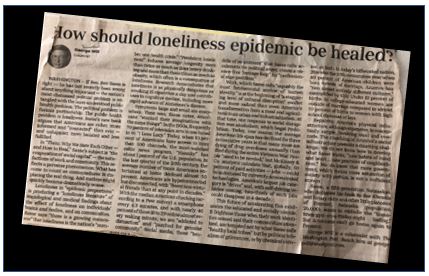In late 2018, an important column by George Will of The Washington Post unwrapped a public health problem called the “Loneliness Epidemic” – how Americans are richer, more informed and so-called “connected” than ever, yet are unhappier, more isolated and less fulfilled.
He called loneliness the nation’s No. 1 health crisis” evidenced by research about anxiety, depression, lack of sleep, mental health concerns and lack of coping mechanisms. Loneliness can be as physically harmful as smoking 15 cigarettes a day and contributes to cognitive decline.
I was shocked to see the data about loneliness and its toll on both personal wellness and the workplace. What IS this “Loneliness Epidemic,” and how does it show up?
Loneliness is not easy to define, according to researcher Stephanie Cacioppo, who notes that feelings of being alone equate to a perception of social isolation – of being disconnected from others.
She believes the mind is the most important factor helping us feeling connected or disconnected. She says, “Lonely people don’t see reality as it is, but as they think it is.”
She argues that loneliness needs to be taken as seriously as physical inactivity and should be tended to regularly. Numerous studies show that feelings of loneliness mark increased risk for morbidity and mortality. Feelings of loneliness and social isolation are associated with increased risk for inflammatory disease[1].
In our hyperconnected society, how can we address loneliness and combat isolation, distraction, unhappiness and the feeling of being overwhelmed? There are no easy answers. Talking about the topic is an important first step.
Loneliness is nothing new. In most cases, it’s quite normal – all of us can feel lonely from time to time.
For example, creativity and innovation often require an intense need to focus, all of which can be healthy and productive, yet also be a bit lonely. During those times, we learn how to pull back from the constant frenzy of life and bombardment of media to create space for our own thinking and reflecting, shunning numerous distractions. It requires discipline and hard work.
But unhealthy loneliness can develop into isolation, hopelessness and despair. Sometimes there’s a fine line between what seems healthy, and what’s not.
Research has shown that people can live solitary lives and not feel lonely, and conversely, they can live ostensibly rich social lives and feel lonely. Loneliness is defined as a distressing feeling that accompanies the perception that one’s social needs are not being met by the quantity or especially the quality of one’s social relationships.[2]
Two decades ago, Robert Putnam addressed the topic of collective “community loneliness” in his bestselling book, “Bowling Alone.” He noted television’s devastating impact on civic engagement and social capital – long before the advent of smart phones.
Smart phones represent Putnam’s “TV” of today and foreseeable future. We cannot deny our addiction to smart phones, distraction, the impact on loneliness, and how people interact with each other.
The average person checks a smart phone every 4.3 minutes and touches it 2,600 times a day[3].
While we’re saturated by smart phone information, many are parched for real community. This distraction is taking a toll on relationships. An unprecedented 70 percent of teens say depression and anxiety are major issues. [4]
College students are spending so much time looking at their phones, that by the end of the semester, many don’t know names of students in their small project groups. This lack of human connection is contributing to the rising number of college students seeking counseling support.
So, what can we do to help ourselves and loved ones beat the loneliness epidemic?
- Talk about it. Get it out of hiding. Loneliness is normal, as we all feel lonely from time to time. But when it grows to be an inward, overwhelming force, get it out in the open. Don’t hide. Reach out. Connect with a trusted friend, family member, licensed counsellor, someone who cares – as well as someone YOU can care about, so that you can put the focus on helping others.
- Make sure you’re not living your life through a screen… whether it be your phone, TV, or other devices. Refuse to be a voyeur and commentator of others’ lives. Commit yourself to becoming the author of your own, beautiful life story.
- Promote more human contact at work. Lead by example.
- Encourage meaningful conversations rather than simple updates.
- Encourage small-group discussions about important topics. Ask for opinions and new ideas.
- Create fun icebreakers where people get to know each other.
- Take opportunities to talk with colleagues rather than send e-mails when in-person conversation would improve communication.
- Encourage work-life integration (there’s no “perfect” balance).
- Get out of your office, get fresh air, and get to know your city. (See my article on how to connect with your city.)
- Love your community and give back. Ask yourself – what are you doing, and what CAN you do, to foster in-person community in your neighborhood, at work, and among friends who share interests in common.
- Connect with nature. Find places in the outdoors and spend time nurturing your soul in nature.
- Get exercise. Physical activity contributes to wellness and well-being, the perfect opposite of loneliness.
- Remember, loneliness, struggles and anxiety are not unique to you. You are not alone in your feelings of aloneness. We all face challenges. We all face overwhelming obstacles and problems from time to time.
None of this is simple. Look up from your phone. Take a few steps. Reach out and find friends who care. Connect with and serve your community. Find a cause bigger than your lonely feelings. Tomorrow will be brighter.
References
Ali, Shainna, Ph.D. LMHC. What You Need to Know About the Loneliness Epidemic. Psychology Today, July 12, 2018.
Barsade, Sigal and Ozcelik, Hakan. The Painful Cycle of Employee Loneliness, and How It Hurts Companies, April 24, 2018.
Cigna 2018 national survey of 20,000 adults, using UCLA’s “Loneliness Scale.”
Hawkley, Lousie C., Ph.D., and Cacioppo, John T., Ph.D. Loneliness Matters: A Theoretical and Empirical Review of Consequences and Mechanisms. Center for Cognitive and Social Neuroscience, University of Chicago, Chicago, IL, USA. Department of Psychology, University of Chicago, 2010.
Pirani, Fiza. Why are Americans so lonely? The Atlanta Journal-Constitution, May 1, 2018.
Putnam, Robert D. Bowling Alone: The Collapse and Revival of American Community. New York: Simon & Schuster, 2000.
Ross, Ashley. The War Against the Loneliness Epidemic. The Daily Beast (TheDailyBest.com), June 30, 2018.
Schawbel, Dan. Fighting the “loneliness epidemic” at work: Creating real connections in the Age of Isolation, Rescue Time Blog, November 22, 2018.
Seppala, Ph.D., Emma M. The Loneliness Epidemic and What We Can Do About It. Psychology Today, June 23, 2017.
U.S. Surgeon General Vivek Murthy report in Harvard Business Review, September 2017.
Will, George. How To Heal Our Epidemic of Loneliness, The Washington Post. Oct 14, 2018.
[1] Hawkley and Cacioppo, 2010.
[2] Hawkley and Cacioppo, 2010.
[3] Pew Research Center.
[4] According to a 2019 study by “1N5: Kids at Risk” conducted by Child Mind Institute.




